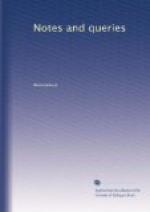The old song on “London Bridge” is printed in Ritson’s Gammer Gurton’s Garland, and in Halliwell’s Nursery Rhymes of England; but both copies are very imperfect. There are also some fragments preserved in the Gentleman’s Magazine for September, 1823 (vol. xciii. p. 232.), and in the Mirror for November 1st of the same year. From these versions a tolerably perfect copy has been formed, and printed in a little work, for which I am answerable, entitled Nursery Rhymes, with the Tunes to which they are still sung in the Nurseries of England. But the whole ballad has probably been formed by many fresh additions in a long series of years, and is, perhaps, almost interminable when received in all its different versions.
The correspondent of the Gentleman’s Magazine remarks, that “London Bridge is broken down” is an old ballad which, more than seventy years previous, he had heard plaintively warbled by a lady who was born in the reign of Charles II., and who lived till nearly that of George II. Another correspondent to the same magazine, whose contribution, signed “D.,” is inserted in the same volume (December, p. 507.), observes, that the ballad concerning London Bridge formed, in his remembrance, part of a Christmas carol, and commenced thus:—
“Dame, get up and bake your pies,
On Christmas Day in the morning.”
The requisition, he continues, goes on to the dame to prepare for the feast, and her answer is—
“London Bridge is broken down,
On Christmas Day in the morning.”
The inference always was, that until the bridge was rebuilt some stop would be put to the dame’s Christmas operations; but why the falling of a part of London Bridge should form part of a Christmas carol it is difficult to determine.
A Bristol correspondent, whose communication is inserted in that delightful volume the Chronicles of London Bridge (by Richard Thomson, of the London Institution), says,—
“About forty years ago, one moonlight night, in a street in Bristol, his attention was attracted by dance {339} and chorus of boys and girls, to which the words of this ballad gave measure. The breaking down of the bridge was announced as the dancers moved round in a circle, hand in hand; and the question, ‘How shall we build it up again?’ was chanted by the leader, whilst the rest stood still.”
Concerning the antiquity of this ballad, a modern writer remarks,—
“If one might hazard a conjecture concerning it, we should refer its composition to some very ancient date, when, London Bridge lying in ruins, the office of bridge master was vacant, and his power over the river Lea (for it is doubtless that river which is celebrated in the chorus to this song) was for a while at an end. But this, although the words and melody of the verses are extremely simple, is all uncertain.”
If I might hazard another conjecture, I would refer it to the period when London Bridge was the scene of a terrible contest between the Danes and Olave of Norway. There is an animated description of this “Battle of London Bridge,” which gave ample theme to the Scandinavian scalds, in Snorro Sturleson; and, singularly enough, the first line is the same as that of our ditty:—




